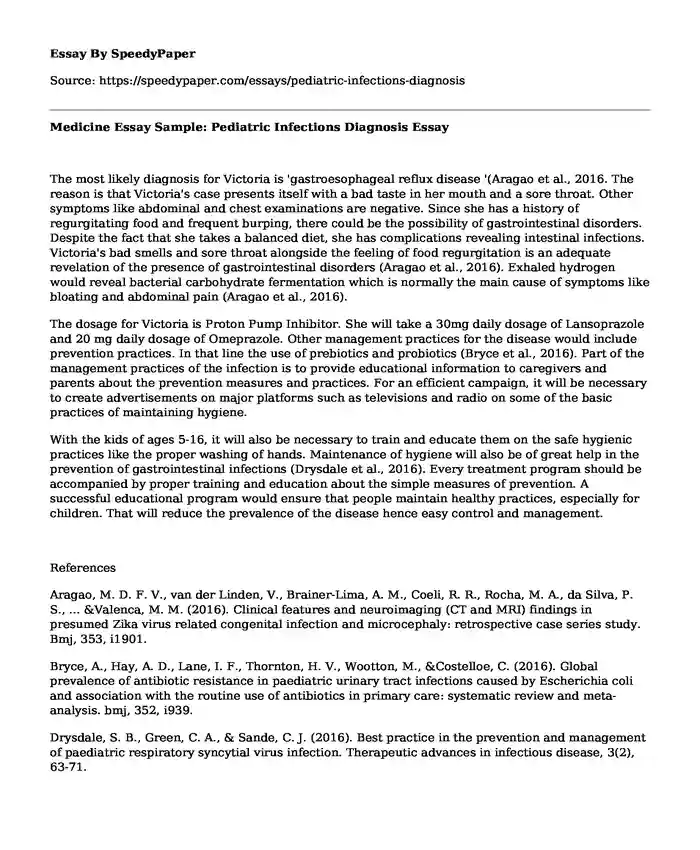The most likely diagnosis for Victoria is 'gastroesophageal reflux disease '(Aragao et al., 2016. The reason is that Victoria's case presents itself with a bad taste in her mouth and a sore throat. Other symptoms like abdominal and chest examinations are negative. Since she has a history of regurgitating food and frequent burping, there could be the possibility of gastrointestinal disorders. Despite the fact that she takes a balanced diet, she has complications revealing intestinal infections. Victoria's bad smells and sore throat alongside the feeling of food regurgitation is an adequate revelation of the presence of gastrointestinal disorders (Aragao et al., 2016). Exhaled hydrogen would reveal bacterial carbohydrate fermentation which is normally the main cause of symptoms like bloating and abdominal pain (Aragao et al., 2016).
The dosage for Victoria is Proton Pump Inhibitor. She will take a 30mg daily dosage of Lansoprazole and 20 mg daily dosage of Omeprazole. Other management practices for the disease would include prevention practices. In that line the use of prebiotics and probiotics (Bryce et al., 2016). Part of the management practices of the infection is to provide educational information to caregivers and parents about the prevention measures and practices. For an efficient campaign, it will be necessary to create advertisements on major platforms such as televisions and radio on some of the basic practices of maintaining hygiene.
With the kids of ages 5-16, it will also be necessary to train and educate them on the safe hygienic practices like the proper washing of hands. Maintenance of hygiene will also be of great help in the prevention of gastrointestinal infections (Drysdale et al., 2016). Every treatment program should be accompanied by proper training and education about the simple measures of prevention. A successful educational program would ensure that people maintain healthy practices, especially for children. That will reduce the prevalence of the disease hence easy control and management.
References
Aragao, M. D. F. V., van der Linden, V., Brainer-Lima, A. M., Coeli, R. R., Rocha, M. A., da Silva, P. S., ... &Valenca, M. M. (2016). Clinical features and neuroimaging (CT and MRI) findings in presumed Zika virus related congenital infection and microcephaly: retrospective case series study. Bmj, 353, i1901.
Bryce, A., Hay, A. D., Lane, I. F., Thornton, H. V., Wootton, M., &Costelloe, C. (2016). Global prevalence of antibiotic resistance in paediatric urinary tract infections caused by Escherichia coli and association with the routine use of antibiotics in primary care: systematic review and meta-analysis. bmj, 352, i939.
Drysdale, S. B., Green, C. A., & Sande, C. J. (2016). Best practice in the prevention and management of paediatric respiratory syncytial virus infection. Therapeutic advances in infectious disease, 3(2), 63-71.
Cite this page
Medicine Essay Sample: Pediatric Infections Diagnosis. (2022, Aug 19). Retrieved from https://speedypaper.net/essays/pediatric-infections-diagnosis
Request Removal
If you are the original author of this essay and no longer wish to have it published on the SpeedyPaper website, please click below to request its removal:
- Hundreds Become U.S. Citizens Just in Time to Vote - Free Essay with Article Review
- Free Essay on Birth Control for Teenagers: Pros and Cons
- Effects of Students Dropping out of High School, Education Essay Sample
- Good Representative - Essay Example
- Is Architecture Art or Science, Get the Answer in Our Essay Example
- Gilded Age and Why It Was a Violent Time - Free Essay Example
- Paper Example: Updike's Short Story "A&P"
Popular categories





